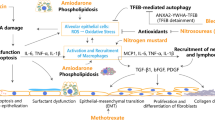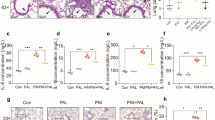Abstract
Pulmonary fibrosis (PF) is the most common complication of paraquat (PQ) toxicity, which lacks an effective treatment. This study aimed to investigate whether exogenous administration of globular adiponectin (APN) isoform provided protection against PQ-induced PF, and examined the possible mechanisms underlying these effects. Eighty BALB/C mice were randomly divided into control, PQ, low-dose APN, and high-dose APN groups. Human lung WI-38 fibroblasts were similarly divided into control, PQ, and APN groups and examined at 24 h, 48 h, and 72 h after PQ exposure. Hematoxylin and eosin (HE) and Masson trichrome staining were used to compare the histopathologic changes in the mouse lung tissues. Western blot and real-time quantitative-PCR (RT-PCR) were used to measure the protein and mRNA expression of transforming growth factor β1 (TGF-β1) in mice lung tissues and α-SMA, type III collagen, and NF-κB p65 in lung fibroblasts. Dihydroethidium (DHE) was used to detect intracellular superoxide anion (O2 −) in fibroblasts. APN administration significantly ameliorated PQ-mediated fibrosis histologically and reduced the protein and mRNA expression levels of TGF-β1 in mouse lung tissues in a dose-dependent manner (P<0.05). When fibroblasts were pretreated with APN, the expression of aα-SMA and NF-κB p65 were down-regulated, and O2 − decreased. Expression of the anti-inflammatory factor IL-1Ra was upregulated following PQ exposure (P<0.05). This study revealed which may have occurred through suppression of NF-κB dependent inflammatory and TGF-β1 mediated fibrotic events.
Similar content being viewed by others
References
Xu, L., Xu, J. and Wang, Z. Molecular mechanisms of paraquat-induced acute lung injury: a current review. Drug Chem Toxicol 37:130–134 (2014).
Yamashita, M., Yamashita, M. and Ando, Y. A long-term follow-up of lung function in survivors of paraquat poisoning. Hum Exp Toxicol 19:99–103 (2000).
Lim, S., Quon, M. J. and Koh, K. K. Modulation of adi-ponectin as a potential therapeutic strategy. Atheroscle-rosis 233:721–728 (2014).
Silva, T. E., Colombo, G. and Schiavon, L. L. Adiponec-tin: a multitasking player in the field of liver diseases. Diabetes Metab 40:95–107 (2014).
Fisman, E. Z. and Tenenbaum, A. Adiponectin: a man-ifold therapeutic target for metabolic syndrome, dia-betes, and coronary disease? Cardiovasc Diabetol 13: 103 (2014).
Marra, F., Navari, N., Vivoli, E., Galastri, S., A. Modulation of liver fibrosis by adipokines. Dig Dis 29:371–316 (2011).
Kamada, Y. et al. Enhanced carbon tetrachloride in-duced liver fibrosis in mice lacking adiponectin. Gas-troenterology 125:1796–1807 (2003).
Kumar, P., Smith, T., Rahman, K., Thorn, N. E. and Anania, F. A. Adiponectin agonist ADP355 attenu-ates CCl4-induced liver fibrosis in mice. PLoS One 9:e110405 (2011).
Ohashi, K. et al. Exacerbation of albuminuria and renal fibrosis in subtotal renal ablation model of adiponec-tin-knockout mice. Arterioscler Thromb Vasc Biol 27: 1910–1917 (2011).
Fujita, K. et al. Adiponectin protects against angioten-sin II-induced cardiac fibrosis through activation of PPAR-alpha. Arterioscler Thromb Vasc Biol 28:863–870 (2008).
Summer, R. et al. Alveolar macrophage activation and an emphysema-like phenotype in adiponectin-deficient mice. Am J Physiol Lung Cell Mol Physiol 294:L1035–1042 (2008).
Miller, M., Cho, J. Y., Pham, A., Ramsdell, J. and Broide, D. H. Adiponectin and functional adiponectin receptor 1 are expressed by airway epithelial cells in chronic obstructive pulmonary disease. J Immunol 182:684–691 (2009).
Yao, R. et al. Adiponectin protects against paraquat-in-duced lung injury by attenuating oxidative/nitrative stress. Exp Ther Med 9:131–136 (2015).
Pulichino, A. M. et al. Identification of transforming growth factor beta1-driven genetic programs of acute lung fibrosis. Am J Respir Cell Mol Biol 39:324–336 (2008).
Luzina, I. G., Todd, N. W., Sundararajan, S. and Atamas, S. P. The cytokines of pulmonary fibrosis: much learned, much more to learn. Cytokine 2014 [Epub ahead of print].
Ruiz, V. et al. Am J Physiol 285:L1026–1036 (2003).
Keane, M. P., Strieter, R. M. and Belperio, J. A. Mech-anisms and mediators of pulmonary fibrosis. Crit Rev Immunol 25:429–463 (2005).
Hardie, W. D., Glasser, S. W. and Hagood, J. S. Emerg-ing concepts in the pathogenesis of lung fibrosis. Am J Pathol 175: 3–16 (2009).
Kaarteenaho-Wiik, R., Paakko, P. and Sormunen, R. Ul-trastructural features of lung fibroblast differentiation into myofibroblasts. Ultrastruct Pathol 33:6–15 (2009).
Kirk, J. M., Heard, B. E., Kerr, I., Turner-Warwick, M. and Laurent, G. J. Quantitation of types I and III collagen in biopsy lung samples from patients with cryptogenic fibrosing alveolitis. Coll Relat Res 4:169–182 (1984).
Lai, C. K., Wallace, W. D. and Fishbein, M. C. Histopathology of pulmonary fibrotic disorders. Semin Respir Crit Care Med 27:613–622 (2006).
Gabbiani, G. The biology of the myofibroblast. Kidney Int 41:530–532 (1992).
Morán, J. M., Ortiz-Ortiz, M. A., Ruiz-Mesa, L. M. and Fuentes, J. M. Nitric oxide in paraquat-mediated toxicity: a review. J Biochem Mol Toxicol 24:402–409 (2010).
Hayden, M. S. and Ghosh, S. Signaling to NF-kB. Genes Dev 18:2195–2224 (2004).
Ortiz-Ortiz, M. A. et al. Nitric oxide-mediated toxicity in paraquat-exposed SH-SY5Y cells: a protective role of 7-nitroindazole. Neurotox Res 16:160–173 (2009).
Morán, J. M. et al. Effect of paraquat exposure on nitric oxide-responsive genes in rat mesencephalic cells. Nitric Oxide 23:51–59 (2010).
Chitra, P., Saiprasad, G., Manikandan, R. and Sudhandiran, G. Berberine attenuates bleomycin induced pulmonary toxicity and fibrosis via suppressing NF-kB dependant TGF-β activation: a biphasic experimental study. Toxicol Lett 219:178–193 (2013).
Tang, A. et al. Inflammasome-mediated IL-1β production in humans with cystic fibrosis. PLoS One 7: e37689 (2012).
Gawarammana, I. B. and Buckley, N. A. Medical man-agement of paraquat ingestion. Br J Clin Pharmacol 72:745–757 (2011).
Choi, J. K. et al. Silica induces human cyclooxygen-ase-2 gene expression through the NF-kappaB signaling pathway. J Environ Pathol Toxicol Oncol 24:163–174 (2005).
Chamberlain, C. S. et al. Interleukin expression after injury and the effects of interleukin-1 receptor antago-nist. PLoS One 8:e71631 (2013).
Gasse, P. et al. IL-1R1/MyD88 signaling and the infla-mmasome are essential in pulmonary inflammation and fibrosis in mice. J Clin Invest 117:3786–3799 (2007).
Hoshino, T. et al. Role of proinflammatory cytokines IL-18 and IL-1beta in bleomycin-induced lung injury in humans and mice. Am J Respir Cell Mol Biol 41: 661–670 (2009).
Korthagen, N. M., van Moorsel, C. H., Kazemier, K. M., Ruven, H. J. and Grutters, J. C. IL1RN genetic variations and risk of IPF: a meta-analysis and mRNA expression study. Immunogenetics 64:371–377 (2012).
Moschen, A. R., Wieser, V. and Tilg, H. Adiponectin: key player in the adipose tissue-liver crosstalk. Curr Med Chem 19:5467–5473 (2012).
Author information
Authors and Affiliations
Corresponding author
Rights and permissions
About this article
Cite this article
Yao, R., He, Y., Zeng, Z. et al. Protective effect of adiponectin on paraquat-induced pulmonary fibrosis in mice. Mol. Cell. Toxicol. 11, 247–255 (2015). https://doi.org/10.1007/s13273-015-0024-4
Received:
Accepted:
Published:
Issue Date:
DOI: https://doi.org/10.1007/s13273-015-0024-4




